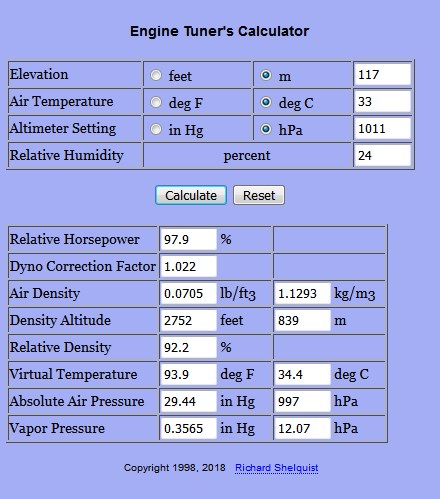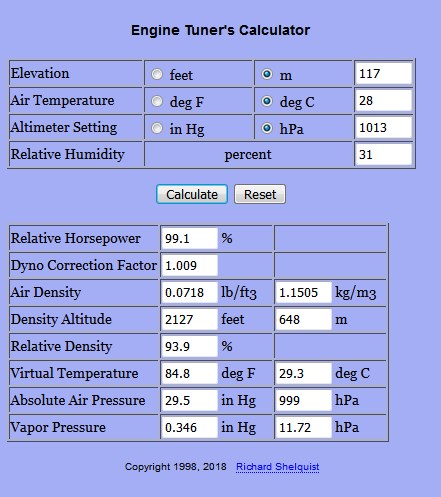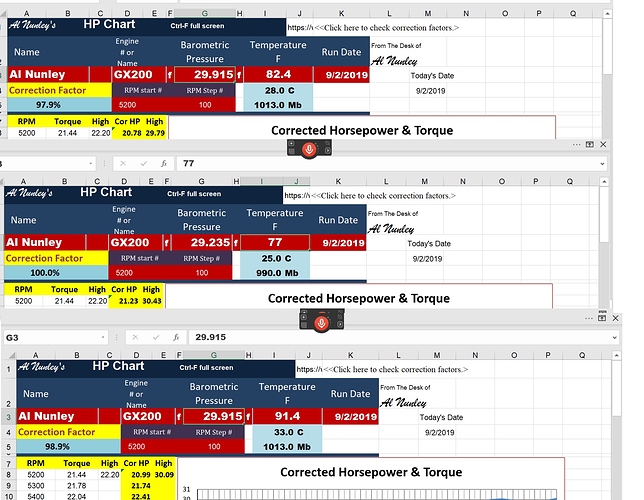https://wahiduddin.net/calc/calc_hp.htm
Here’s a calculator, online, if you’re interested in knowing how much humidity effects horsepower. At sea level, at a standard atmosphere, (77° at 29.235 barometric pressure) in the range of 50% to 70% relative humidity, the correction factor only changes .009 %. From .017 to .028. Let’s see; 15 hp x .028 = -.405 hp. 15 hp x .017 = .255 hp. The difference being .250 hp. Hardly momentous, but still, something to keep in mind. And the fact that you are racing in the same air as everybody else, what difference does it make. A very good reason for the air density gauge. As air becomes less dense, your engine gets richer.
May I ask, what is Altimeter setting in one of the boxes and what values should I type in? In other words where do I find those values? I understand everything else, pretty much the basic info you get at your weather forecast app.
I was a little confused by that also, so I put in the number 1, for sealevel. With 77° and 29.235 barometric pressure, the calculation came out to 100% with zero humidity. Adding humidity then change that calculation.
Alright, thanks, I will try it out!
plug in these numbers…
elevation: 920
pressure: 29.235
94 degrees
45% humidity
look at “relative hp” … 91.6% … so a “20hp” engine, if tuned perfectly would deliver 18.32hp.
Now… a quick shower rolls through… sun comes back out, track is drying, it didn’t cool off much but humidity spiked.
92 degrees
96% humidity
… relative hp drops to 89% or 17.8hp… a 1/2 hp drop IF you got the mixture right. Getting the mixture right is tricky because even though the temperature dropped a little you actually have to lean the mixture due to the humidity.
To see this change the numbers and watch the “relative temperature”. The air temperature dropped 2 degrees but you have to tune like the temperature went up 3.5 degrees because the humidity spiked.
That’s all interesting stuff isn’t it, and I have no doubt the calculations are correct. Still, we’re all still racing in the same humidity, so it effects all of us exactly the same. On that same homepage, with the corrected horsepower numbers, in the left-hand column near the bottom there’s an article on HP correction factors, interesting reading.
I’m wondering; how do you tune for humidity, what method do you use, other than adjusting the carburetor, to achieve the fastest lap times? And, with a fixed jet carburetor, seeing as how it can’t be adjusted once the race starts, what you do? Longacre says; check the air density. To compensate for a 1% change in air density, you change your air/fuel mixture 1%. To know how accurately you’ve compensated for the conditions, an exhaust gas temperature gauge (EGT) is a very good tool. Don’t go to the racetrack without it!! lol
Tuning is tough! (Al Nunley)
If the data does not support the theory, get a new theory. (Al Nunley)
This works for sure. I have tested it, and it does say I have 1.2% more HP at the night than at the moment.
1011mbar 1013mbar
33°C vs 28°C
24% Humidity 31% Humidity
16:30 21:10
97.9% HP 99.1% HP
So this calculator is proving what I was told at the track. So other factor is of course the tyre grip. There is no calculator for that lol.
Very cool! As far as the tires are concerned you definitely had better grip at night I think.
The horsepower difference could be looked at as 1.0122574055% increase as well.
50% vs 75% HP is it a 25% difference, 50% more or a 1/3 less?
It depends what it is relative to.
Strange, I come up with the exact opposite % HP. And I wonder, shouldn’t those final percentages be labeled “correction factor”.
No idea really, there are the screens:


Let’s call the left picture number 1 and the right number 2. You run your engine under the conditions in number 2 and you get a horsepower number from your dyno at 5000 RPM. Let’s choose 10 HP. You multiply that HP number by the relative horsepower number and you get 9.91 HP. That’s the corrected horsepower number.
Now you make anotherr dyno run. This time you get 10.11 HP. But the conditions have improved, so you want to know how much horsepower you would be making if the conditions were the same as in number 2.

If you’re wondering, I’m just sitting here at home, with nothing to do, so I did this. SAE standard atmosphere 29.235 BP 77° temperature. Not being really good at metrics, I put them both on this spreadsheet, just so you can see the difference. The Celsius number and the Mila bar number are calculated from the barometric pressure and temperature degrees. Your numbers, top and bottom, standard atmosphere center. In these examples, as you can see, the torque reading doesn’t change because it’s the actual number from the dyno run. The horsepower numbers changes because it’s corrected to the conditions. Barometric pressure and temperature. Dry air.
Hmmm…I kind of understand what you are saying but, one thing I don´t. Is it, by the calculations at the end, better for engine to run at the conditions from picture number one or number two? I understand that torque doesn´t change and it can´t really, but I guess .1HP can give a slight boost?
The purpose of the illustration was to show that, only if the torque readings stayed the same, and they most likely would not, with changing temperature and pressure, the corrected horsepower numbers would change.
Horsepower is a calculation, it tells you how much work (torque) you are producing in a given amount of time. James Watt figured all this stuff out and you can read about it on Wikipedia. Most farmers, in the 1800s, were familiar with the amount of work a horse could do, so James Watt came up with a way to show them how much work his steam engine could do compared to horses.
When speaking of humidity, you must realize that the number you hear on the news is “relative humidity”. That means; the amount of moisture (water vapor, a gas like any other gas) in the air, as a percentage of how much water vapor the air could hold at the present temperature. For example, let’s say it’s 80° and the relative humidity is 40%. Just for illustration purposes, let’s say the temperature goes to 85°, and the relative humidity is now showing 35% (not real numbers). Because it’s a “relative humidity” number, the “actual” amount of water vapor in the air may not have changed at all. At 100°, and 100% relative humidity, water vapor would comprises 4% of the air your breathing. If you charted the actual amount of water vapor in the air at any given temperature, you would find it’s a “bell curve”, meaning the hotter the air, the more water vapor, as a percentage, it can hold. There’s so much more to this, but bottom line is, humidity (actual) has only a small effect on the horsepower numbers. I’ve thought about buying a weather station, Amazon sells them, but the cost outweighs the benefits.

